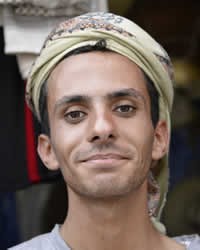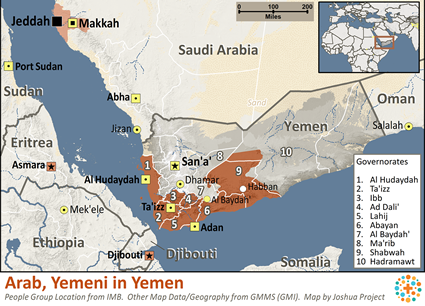The Arabs from the Arabian Peninsula are the original Arabs. Tribes of nomads from the Arabian Desert developed Arab culture. From there, they expanded into what we now know as the Arab World, where Arabic is the key language.
Yemenis started migrating north during the pre-Islamic era. Many Arab families with common names (e.g., Haddad, Haddadeen, which means Smith or metalworker) that have long family trees in Syria, Lebanon, Palestine and Jordan trace their ancestry to that early migration from Yemen. For example, the family name, Haddadeen, originated in Sana'a.
There are many Arabic dialects spoken in Yemen. Today, there is a sharp division between Yemeni from the northern tribes and the southern ones. Those from the north descended from Mesopotamians, who entered their land 1,000 years before Christ. They claim Ismail from the Book of Genesis, and their patriarch. Those from the south believe they descended from Qahtan, also known as Joktan, in the Bible.
The north and the south were separate nations in the 70s and 80s; one backed by communists and the other by the West. They merged for a couple of years, but now they are fighting once again. Iran backs one side using Shia Islam as their banner, while the other supports a Sunni Muslim head of state. Yemenis would love to have the fighting stop, but the situation is out of their control.
Yemen is a country that has, in recent decades, been defined by civil war. They have been divided at one point, and even after being unified as one nation, there has been fighting and division. Foreign nations such as Iran, Saudi Arabia and the U.S. have sent in weapons and even soldiers. The situation has left Yemen in a tragic situation. The economy is at a standstill. War deaths are in the hundreds of thousands. Cholera and other diseases go unchecked. Famine is a real possibility. As always happens in these situations, the women and children are the most likely to suffer.
The growing of the drug qat has become the mainstay of rural Yemen, and nearly half of the national economy is involved in qat. This uses valuable water in a dry land which could otherwise grow food.
The Yemeni Arabs have had a close association with Islam since it began in the 600s. Today, nearly all the Yemeni Arabs are Muslim, no matter where they live. Two-thirds of Yemenis adhere to some form of Sunni Islam, and about one-third are Shia Muslims. Though they vary in terms of tribal loyalty, one thing Yemeni Arabs all agree on is devotion to the Islamic religious system. Almost none of them have put their trust in Jesus Christ, no matter where they live.
Yemeni Arabs in diaspora need peace in their homeland. All of them have family members whose lives are in jeopardy because of the fighting. There will be no end to the fighting until there is humble repentance and the acknowledgment that they must submit to the sin-free Savior. They need the intervention of Jesus Christ.
Pray for a lasting and just peace in Yemen that will allow the gospel to penetrate this Islamic land.
Pray for the Lord to use the instability in Yemen to help Muslim Yemenis to understand they need a sin-free savior.
Pray for the small number of Yemeni believers to boldly proclaim the gospel to their families, friends and neighbors.
Pray for small, extended-family based home fellowships to multiply among Omani Arabs.
Scripture Prayers for the Arab, Yemeni in Yemen.
https://arabcenterdc.org/resource/a-timeline-of-the-yemen-crisis-from-the-1990s-to-the-present/
https://www.cfr.org/backgrounder/yemen-crisis
| Profile Source: Joshua Project |


























